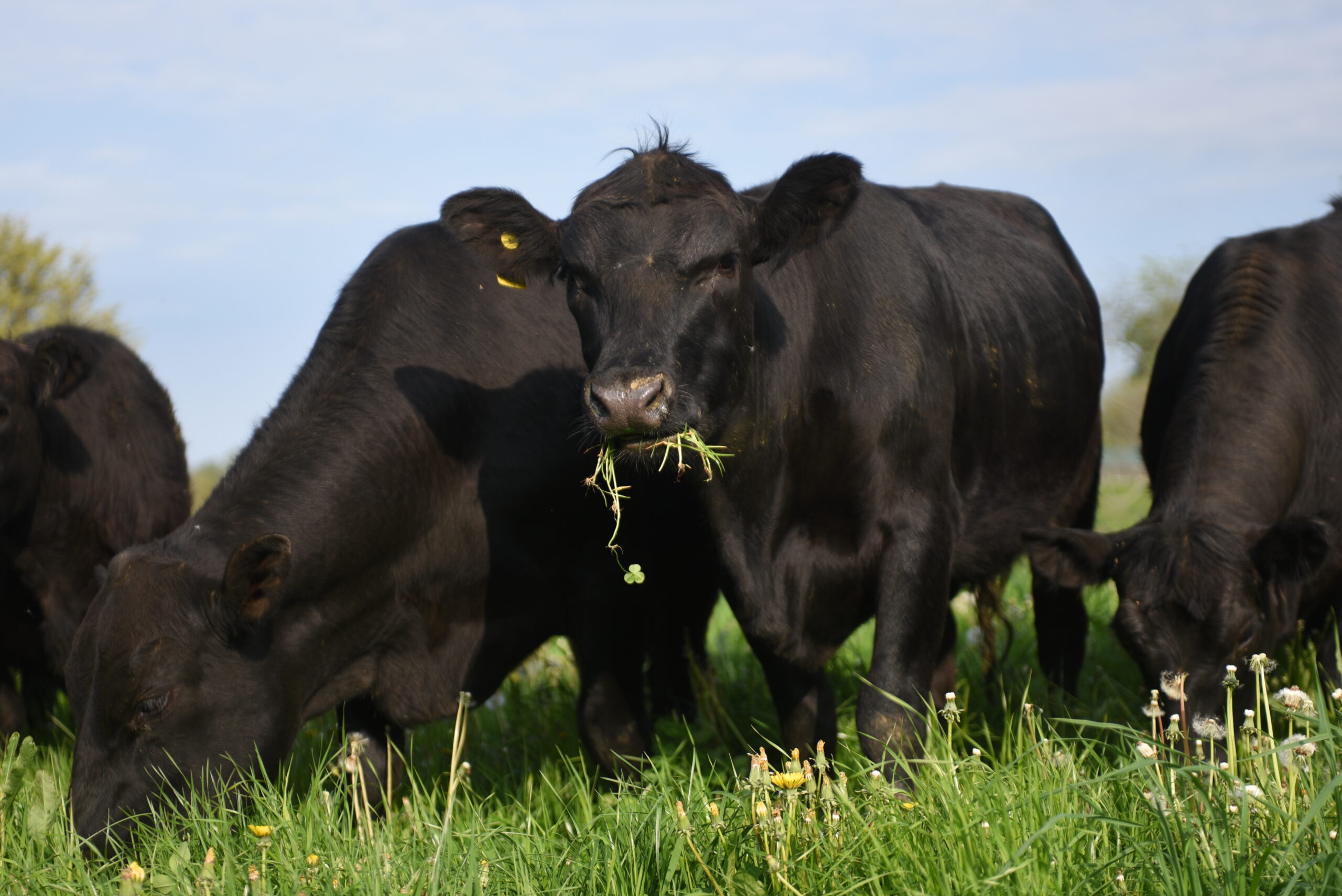Beef Supply is Low Nation Wide (Feb 2025)
Where's the Beef?
Food costs have been a hot topic for a few years now. It seems like the populist thing for politicians to claim they are going to bring them back in check. I hate to break it to you, but there is very little they can do. Right now we are dealing with basic economics - supply and demand.
At Fresh Fork, have been slightly insulated from some of the big swings in the market because we raise quite a bit of our own beef and work directly with local farmers. I also happen to be a butcher and farmer, so I can work a little smarter on sourcing.
For example, at Fresh Fork we sell a lot of ground beef. Way more than any one steer would produce. We struggle to sell cuts - steaks, bottom round, etc.- because I've learned that most customers prefer those fresh and to see them with their own eyes. As a result, I can cull out cows - mommas who need to be replaced in the herd, and grind those for burger at a lower price than a fat steer. In my opinion, this produces the best ground beef - rich in iron and nutrients, dark in color, and flavorful. It's also a way for us to keep our prices down.
These strategies and our long term commitments to our growers have helped us keep our prices reasonable. And market conditions are playing to the favor of us selling grassfed beef. Right now, what we are seeing now is that commodity, confinement beef is now catching up to the price of pasture raised, grassfed beef. Hang in here with me as I explain the industry some.

they are heifers, not cows
First, some definitions. This is kind of an inside joke. My nieces and nephews come to the farm and want to see the cows. I have to correct them.
"That's a heifer, not a cow." Which kind of leads into the birds and bees talk. So here are some definitions:
Cow - the momma who has a calf and nurses it
Bull - the father. Lean, muscular and has to get "in condition" to breed up to 50 cows.
Heifer - the young female, not bred
Steer - a castrated male
Historically speaking, steers were what we ate. By neutering them, they produced less testosterone and would put on "condition" better - meaning fat.
Heifers were traditionally kept to grow the herd. They would be bred by a bull (or artificial insemination) and the calf either raised on the farm for meat or sold off as a "stocker."
3 types of producers in the beef industry
Very few beef producers raise animals from cow to finish. That's fairly unique to small, local farmers.
Traditionally, there are different players who are generally geographically separate.
COW/CALF OPERATION - these are operations where cows are generally allowed to roam "on range," have a calf, and then the calves are sold off in the spring or fall.
COW/CALF operations require a lot of land and average quality grass. You'll find a lot of these type operations in southeastern Ohio, Kentucky, West Virginia, and Tennessee (as well as Colorado and TX). It's a good use for land that isn't flat and of moderate value. The land is not rich enough to grow crops, but it's just right (and priced right) for low-density stocking of cattle. These producers typically take their calves (400 to 500#) to a "sale barn" where they are auctioned off and shipped out west. Zanesville (OH), Paris (KY), and Ripley (WV) are all popular markets for calf producers.
BACKGROUNDER - these are guys who buy weaned calves and get them "bunk broke," meaning they introduce them to grain and feeding them in a confined feeding area.
The BACKGROUNDERS are usually out west. Kansas, Texas, and Oklahoma are popular locations. Here, land is cheap and they are getting closer to the feed-lots and the corn belt of Iowa, Illinois, and the Dakotas. Backgrounders can have different pens setup outside in open-air lots. They'll sort calves based on size and condition. The goal is to get a truck-load ready at the same weight, approx. 750 to 850#. These are then easy to market to someone who is going to finish them.
FINISHER/FEED LOT - this is where groups of calves are finished on a high energy diet (corn and beans) in a confined feeding operation.
Finally, the stockers end up in a FEED LOT, usually out west near big packing plants. Sous City (Iowa), Omaha (NE), and Dodge City (KS) are large beef packing hubs, so the feed lots have developed near those markets. On a feedlot, cattle are kept in groups in a confined feeding area. High energy corn, soybeans, and molasses are brought to them in a either a mash (ground feed) or pelleted form. Here the cattle grow quick and put on layer so fat.
BEEF INVENTORIES ARE LOW NATION WIDE (FEB 2025)
Coming back to supply and demand, what is happening to the beef industry right now is completely driven by a lack of inventory.
Inventory can't be changed quickly. The gestation cycle of a cow is 9 months. That calf requires about 2 years to finish. So to increase supply, we are 2.5 to 3 years out.
Big cow/calf operations out west reduced their herds due to drought. This means less calves. Now, calves from out east are getting more expensive and being shipped around the country.
As prices went up on calves, producers started selling off heifer calves to supply something to the backgrounders and feed lots. With less heifers getting bred, the supply continued to shrink.
Then, as prices went up, so did the value of "cull cows." Cows that used to be worth $0.50 to $0.70 per lb for grinding are now selling at $1.40 to $1.60 per lb. It became very attractive to start culling older cows for an immediate paycheck.
Typically, beef is a big export item. In 2024, imports of beef exceeded exports for the first time in a long time. The beef coming into the US is typically low quality - lean, processing grade beef used in hot dogs, lunchmeats, and other products.
American cattlemen then discovered that every pound counts, so the feed-lot guys started keeping cattle longer. This mean larger carcasses and more pounds of meat per carcass. It also has further restricted supply. Where a beef used to "dress" 750 to 800#, now 900# and higher is the new average. These carcasses are also fattier, meaning the processors need more lean beef to help utilize all the excess fat. Prices of bulls have even gone to record highs to help supply lean meat to help utilize fat.
for small producers, the price of calves is impacting our operations
The last few years have been a whirlwind in beef prices. I reduced my cow herd several years back because of the land it required. I didn't have enough and couldn't find enough fenced pasture to rent.
I started buying calves directly from other farmers who had the genetics I desired. Then prices started creeping up. It wasn't fair to ask them to sell calves below market price.
For my models, I used to figure that $2 per lb for a 500# calf was about as high as I could go. I had fancy spreadsheets where I calculated the cost of production - from the value of the hay I could produce per acre if I weren't grazing to the time I put into each calf. By the spring of 2023, I couldn't get calves anywhere close to $2 per lb. $2.40 became the new norm then.
In 2024, we thought it had peaked. $2.75 to $3 per lb was starting to be common, then by fall of 2024, $3.25 and $3.50 were becoming common.
Today, a 500# calf sells for about $3.50 per lb, which is about $1,700 per calf. That calf will require another 16 to 18 months on pasture - and two winters - before it is finished. Current market prices are around $2 per lb live weight. That means that a 1,100# finished beef is only worth $2,200. So I have to be able to finish my beef at a price of about $30 per month. $1 per day. That's tough to do. Or hope prices keep going up.
To try to increase supply, the big industry is starting to really focus on what's called "Beef on Dairy." This means a beef breed bull - like angus - bred to a dairy heifer (Holstein). The result is a cross-bred heifer or steer that is very consistent in size (because dairy genetics are very consistent). These animals are being put on feed lots to help increase supply.
The trade-off is though that now less dairy heifers are being bred back. You can't get milk if the heifer or cow isn't bred. If she never has a calf, you'll never get milk. Now milk supply is shrinking and milk prices are going up. Dairy farmers who want to grow their milk supply can't afford to buy heifers due to the price increase there.
So my prediction for 2024 and 2025 are that beef prices aren't going down. In fact, they may keep going up. I also expect that milk, cheese, butter, cream, and ice cream are all going to increase in price. Egg prices are going to be impacted at least until the middle of summer.
I hope you appreciate this little bit of insight into the agriculture world. I feel that this is another example - like the supply chain issues and food shortages associated with Covid - that reinforce why we should buy local and protect our local "foodshed." The globalization of our food system sounds great on paper - specialization leads to lower costs and higher productivity - but it doesn't account for sacrifices in quality, the long term cost to our health, and the risk associated with events happening outside our area - such as drought and forest fires out west, bird flu in confinement operations, etc. It's all a beautiful system, until it breaks.
